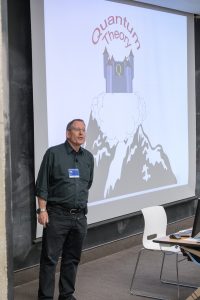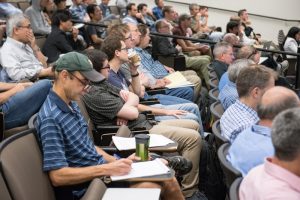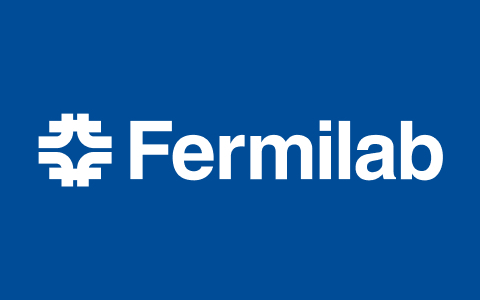From Sept. 12-14, more than 100 physicists, engineers and industry partners gathered at Fermilab for a workshop on quantum science and its applications to high-energy physics. Fermilab scientists organized the workshop, which included hands-on tutorials presented by Google.
“That’s the first time Google has given tutorials on their quantum software to the community in a format as big as this one,” said Panagiotis Spentzouris, head of quantum science at Fermilab.
It was just one example of the kind of boundary-crossing interactions that Spentzouris and his colleagues aimed to explore. Industry met with academia. Early-career researchers met with seasoned experts. And theorists and experimentalists discussed areas of common quantum-science interest they could tackle together.
Spentzouris said the workshop met both of its major goals: to foster relationships within the physics research community and to deliver software infrastructure that will allow researchers to access quantum computers and simulators.
“Our aim was to build community, identify algorithms that can be put on quantum hardware in the near future, and, through our partnership with Google, host hands-on tutorials so people can get an idea of how to run this stuff,” Spentzouris said. “That’s what we achieved.”
A wonderful problem

California Institute of Technology physicist John Preskill discussed advances in quantum information science at the workshop’s colloquium. Photo: Reidar Hahn
In a 1981 lecture that presaged the potential applications of quantum computers, Richard Feynman said, “Nature isn’t classical, dammit! And if you want to make a simulation of nature, you’d better make it quantum mechanical, and by golly it’s a wonderful problem, because it doesn’t look so easy.”
Developing quantum computers that can run quantum simulations of quantum physics phenomena is anything but easy. But the payoff for particle physics could be solutions to problems that are virtually impenetrable to classical computers.
Contemporary quantum computers typically have just a handful of qubits, or quantum bits, which correspond to classical computer bits. The most powerful quantum computers max out at around 50 qubits. Contrast that with the average laptop’s 40 billion bits.
But even a small number of qubits gives quantum computers extraordinary potential, because each added qubit doubles the computer’s memory and processing power.
Yet another challenge lies in the fact that the computers’ quantum logic gates — the decision-making building blocks of quantum computer circuits – are error-prone, or “noisy,” which limits the size of quantum circuits that scientists can currently construct.
“No one is sure how useful these noisy near-term quantum computers will be. We’ll experiment with them over the next few years to find out,” said John Preskill, a theoretical physicist at the California Institute of Technology, who presented the workshop’s colloquium.
“Eventually we’ll have truly scalable quantum computers, which will have interesting applications to simulation of quantum systems. These more powerful quantum computers will have many more qubits than today’s devices, and may still be many years away,” Preskill said. “To get there we’ll need quite a few advances, including better qubits and better ideas for controlling noise. It’s important for the basic research community to continue exploring hardware platforms that are different from the ones we’re using today.”
Beyond computing
The prospects for quantum computing are the main drivers behind quantum science, but the quantum science umbrella covers more than particle physics simulations.
Qubit-based technologies, such as quantum communication and sensors, were the focus of several workshop talks. For example, scientists are looking to exploit the phenomenon of quantum entanglement — something Einstein called “spooky action at a distance” — to send messages across fiber-optic networks. And they’re developing qubit-based sensors that can detect single photons of light, which could aid in the search for dark matter.
“Quantum is a big tent,” said Fermilab Deputy Director and Chief Research Officer Joe Lykken. “It’s for more than simulating complex physics problems. The fact that we can develop networks and detectors based on quantum principles is one of the most exciting aspects of this field.”
Connecting communities

Participants attended lectures on quantum science and a hands-on demonstration of quantum computing software presented by representatives from Google. Photo: Reidar Hahn
Attendees included scientists whose work is focused on quantum physics, as well as researchers from condensed matter or nuclear physics backgrounds. Building a more interconnected research community was a key focus of the workshop.
“I think especially in the quantum world, you have people coming from very diverse backgrounds that don’t necessarily know each other but have a lot to teach each other,” Lykken said. “They are trying to solve similar problems to what we’re interested in in high-energy physics. It’s very much an example of a community that needs to know each other better and learn from each other. I think this workshop was an attempt to do that on a pretty large scale.”
Natalie Klco, a graduate student at the University of Washington who presented a talk on quantum computing, also noted the importance of bringing experimentalists and theorists together.
“It’s really nice to have the ability to converse with them to find out what’s hard on the hardware, what’s easy, what can we take advantage of to make some really clever experiments,” she said.
And, of course, the workshop provided a prime opportunity for scientists to talk with members of industry.
In the workshop tutorial, Google software developers Craig Gidney and Kevin Sung introduced scientists to Cirq, an open-source framework for developing quantum algorithms, and OpenFermion, a library that can compile and analyze them. Gidney presented on Cirq, which is designed to help scientists ascertain whether intermediate-scale quantum computers can handle complex computational problems. In the tutorial, Sung demonstrated the software’s ability to solve the Schrödinger equation for the Fermi-Hubbard model, a classic quantum mechanics problem.
“I’m coming from a bit more of a traditional physics perspective, so the Google software tutorial, for example, helped a lot,” said Andy Li, a postdoctoral research associate. “It will be useful for my work in digital quantum simulation.”
All kinds of opportunities
Lykken highlighted the importance of making early-career scientists aware of the fact that quantum information is a field that is part of the future of physics research.
“It’s not just a fad; it’s not going away,” he said. “And if younger researchers want to spend some fraction or all of their research time delving into the many aspects of quantum information sciences, then that’s a good thing for them to do. It’s something that’s opening up. The opportunities are boundless.”
